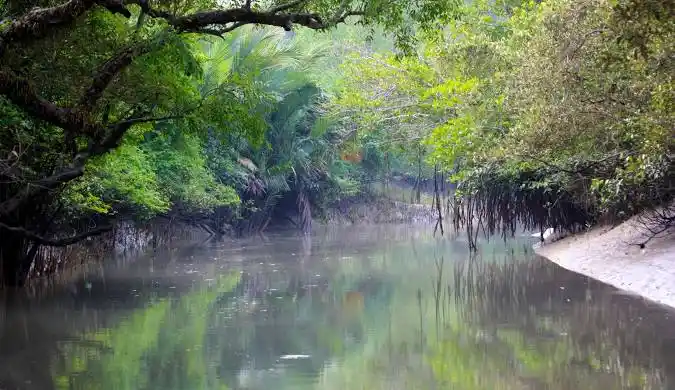The Sundarbans, a vast mangrove forest sprawling across the delta of the Ganges, Brahmaputra, and Meghna rivers, is a unique and awe-inspiring region that stretches across southern Bangladesh and the eastern coast of India. This intricate ecosystem, with its labyrinthine waterways, lush greenery, and rich biodiversity, is not just a natural wonder but also a Indian cultural and economic cornerstone for the millions who live in its proximity. This article delves into the multifaceted aspects of the Sundarbans, exploring its geography, wildlife, cultural significance, environmental challenges, and conservation efforts.
Geography and Hydrology of Sundarbans
Sundarbans Geographic Overview
The Sundarbans covers an area of approximately 10,000 square kilometers, making it the largest tidal halophytic mangrove forest in the world. The region is predominantly situated in the southern part of Bangladesh, with a smaller portion extending into the Indian state of West Bengal. The forest is characterized by its intricate network of tidal waterways, mudflats, and small islands, all interwoven in a delicate balance.
Hydrological Dynamics
The hydrology of the Sundarbans is complex, influenced by the tides of the Bay of Bengal and the seasonal monsoon rains. The region’s water system is marked by an intricate web of rivers, streams, and tidal channels, which create a dynamic and ever-changing landscape. The freshwater influx from the Ganges, Brahmaputra, and Meghna rivers interacts with the saline waters of the Bay of Bengal, resulting in a unique brackish environment that supports a diverse range of flora and fauna.

Biodiversity and Wildlife of Sundarbans
Flora
The Sundarbans is renowned for its rich biodiversity, particularly its mangrove trees. The dominant species in the forest is the Sundari tree (Heritiera fomes), from which the region derives its name. Other significant mangrove species include the Keora (Sonneratia apetala), the Goran (Ceriops decandra), and the Palash (Butea monosperma). The forest’s vegetation plays a crucial role in stabilizing the coastline, preventing soil erosion, and providing habitat for numerous species.
Fauna
The wildlife of the Sundarbans is equally impressive. The Bengal tiger (Panthera tigris tigris) is the most iconic inhabitant, with an estimated population of around 100 individuals in the region. These tigers are specially adapted to the mangrove environment and are known for their swimming prowess. Other notable species include the saltwater crocodile (Crocodylus porosus), the estuarine crocodile, various species of deer, wild boars, and a plethora of bird species such as the Bengal florican and the white-bellied sea eagle.
Human Settlements and Culture of Sundarbans
Indigenous Communities
The Sundarbans is home to several indigenous communities who have adapted to the region’s challenging environment. The most prominent among them are the Bagdi, the Bhumij, and the Munda tribes. These communities have developed unique cultural practices and traditional knowledge systems that are closely linked to the forest and its resources.
Traditional Livelihoods
Fishing, honey collection, and crab farming are traditional livelihoods for many residents of the Sundarbans. The region’s rich aquatic resources support a diverse range of fisheries, while the honey collected from wild beehives is a valuable commodity. However, these traditional practices are increasingly being threatened by environmental changes and human encroachment.
Environmental Challenges of Sundarbans
Climate Change
Climate change poses a significant threat to the Sundarbans, impacting its delicate balance. Rising sea levels, increased salinity, and more frequent and severe cyclones are all consequences of climate change that are affecting the region. The forest’s ability to provide a buffer against storm surges and coastal erosion is being compromised, putting both the ecosystem and local communities at risk.
Deforestation and Habitat Loss
Deforestation, driven by logging and land reclamation for agriculture, is another major concern. The loss of mangrove forests not only threatens the wildlife that depends on them but also diminishes the region’s natural defenses against coastal erosion and flooding. Efforts to manage and protect the forest are crucial for preserving its ecological integrity.
Pollution
Pollution from agricultural runoff, industrial activities, and maritime traffic is contaminating the waterways of the Sundarbans. This pollution affects both the flora and fauna of the region, disrupting ecosystems and posing health risks to local communities. Addressing pollution requires coordinated efforts across borders and sectors.

Conservation Efforts of Sundarbans
Protected Areas and Reserves
To safeguard the unique biodiversity of the Sundarbans, several protected areas and reserves have been established. In Bangladesh, the Sundarbans Reserve Forest is a designated UNESCO World Heritage Site, while in India, the Sundarbans National Park is a recognized protected area. These conservation efforts aim to preserve the natural habitat, protect endangered species, and promote sustainable management practices.
Community Involvement at Sundarbans
Effective conservation of the Sundarbans involves the active participation of local communities. Initiatives such as community-based forest management, eco-development projects, and awareness programs are crucial for fostering a sense of stewardship among residents. Engaging local communities in conservation efforts helps ensure that their livelihoods are sustained while also protecting the environment.
International Cooperation
Given the transboundary nature of the Sundarbans, international cooperation is essential for effective conservation. Collaborative efforts between Bangladesh and India, as well as support from international organizations, play a vital role in addressing the challenges faced by the region. Joint research, conservation programs, and policy initiatives are critical for protecting the Sundarbans.
Cultural Significance of Sundarbans
Folklore and Traditions
The Sundarbans holds a special place in the cultural and spiritual life of the people who live in and around it. The region is rich in folklore, myths, and legends, many of which revolve around the Bengal tiger and the mystical qualities of the forest. Traditional festivals, rituals, and ceremonies are often linked to the natural rhythms of the forest and its waterways.
Art and Literature
The beauty and mystery of the Sundarbans have inspired numerous works of art and literature. Poets, writers, and artists have drawn on the region’s landscapes, wildlife, and cultural heritage to create evocative and memorable works. These artistic representations not only celebrate the Sundarbans but also raise awareness about its significance and the need for conservation.
Tourism and Ecotourism of Sundarbans
Ecotourism Opportunities
Tourism, particularly ecotourism, offers opportunities for sustainable economic development in the Sundarbans. Carefully managed tourism can provide income for local communities while promoting conservation awareness. Boat tours, wildlife spotting, and guided treks are popular activities that allow visitors to experience the forest’s natural beauty.
Challenges of Tourism
While tourism has potential benefits, it also presents challenges. Unregulated tourism can lead to environmental degradation, disturbance to wildlife, and cultural disruption. It is crucial to implement sustainable tourism practices that minimize negative impacts and ensure that the benefits of tourism are equitably distributed.
Sundarbans Forest Animals
The Sundarbans, one of the largest mangrove forests in the world, is home to a diverse range of animals, many of which are adapted to the unique environment of the delta. Some of the key animals found in the Sundarbans include:

1. Bengal Tiger:
- The Bengal tiger is perhaps the most famous inhabitant of the Sundarbans. The forest is home to a significant population of these majestic creatures, and it is one of the few places in the world where tigers have adapted to living in a mangrove ecosystem. The tigers are well known for their ability to swim long distances and hunt in the water.
2. Saltwater Crocodile:
- The saltwater crocodile, the largest of all living reptiles, can also be found in the Sundarbans. These powerful predators inhabit the tidal waters and are capable of attacking large animals, including tigers and humans.
3. Spotted Deer:
- The spotted deer (or chital) is commonly found in the Sundarbans, providing an important prey source for the tigers. These deer are often seen in herds and are known for their distinctive white spots on their brown fur.
4. Wild Boar:
- The wild boar is another species found in the Sundarbans. These pigs are well-adapted to the region and are often seen in the forested areas. They are an important part of the food chain, both as prey for predators and as scavengers.
5. Fishing Cats:
- The fishing cat, a small but fierce feline, is well adapted to the Sundarbans’ aquatic environment. It is an excellent swimmer and preys on fish, crabs, and other small animals in the mangrove swamps.
6. Hawksbill Turtle:
- The hawksbill turtle, an endangered species, can be found in the Sundarbans’ coastal waters. These turtles are known for their distinctive beak-shaped mouths and are important for maintaining the balance of marine ecosystems.
7. Mangrove Monitor:
- The mangrove monitor, a type of large lizard, inhabits the forests and shores of the Sundarbans. It is an excellent climber and swimmer, and it preys on small animals and birds.
8. River Dolphin:
- The river dolphin, also known as the South Asian river dolphin or Irrawaddy dolphin, is found in the freshwater rivers and tidal waterways of the Sundarbans. These dolphins are highly endangered and are adapted to living in the brackish water of the region.
9. Monkeys:
- Rhesus macaques and banded langurs are commonly found in the Sundarbans. They inhabit the forests and are often seen foraging for food or moving in troops.
10. Birds:
- The Sundarbans is a haven for birdwatchers, as it is home to a wide variety of bird species, including the kingfisher, herons, egrets, and parakeets. The region also serves as a crucial stopover for migratory birds.
These animals, along with a variety of fish, amphibians, and invertebrates, make the Sundarbans a critical ecosystem for biodiversity and an important area for conservation efforts.

Best Time To Visit In Sundarbans
The best time to visit the Sundarbans is during the winter months, from November to February, when the weather is most favorable for exploration. The temperatures during this period are cool and comfortable, ranging from 12°C to 25°C (54°F to 77°F), making it perfect for boat rides and wildlife watching. This is also the prime season for spotting the elusive Bengal tiger and other wildlife, as the animals are more active in the cooler weather. The humidity levels are lower, and rainfall is minimal, unlike the monsoon season (June to September), when heavy rains can disrupt travel plans. Although summer (March to May) is also a viable time to visit, it can be quite hot and uncomfortable, with temperatures soaring above 40°C (104°F). For a more enjoyable and rewarding experience, the months between November and February offer the best conditions to explore the beauty and biodiversity of the Sundarbans.
Conclusion
The Sundarbans is a region of profound ecological, cultural, and economic significance. Its complex ecosystems, rich biodiversity, and vibrant human communities make it a unique and invaluable part of our natural heritage. However, the challenges posed by climate change, deforestation, pollution, and unsustainable practices threaten the future of this remarkable forest.
Addressing these challenges requires a multifaceted approach, including effective conservation strategies, community involvement, and international cooperation. By fostering a deeper understanding of the Sundarbans and committing to its preservation, we can help ensure that this extraordinary region continues to thrive for generations to come.
As we reflect on the Sundarbans’ beauty and importance, let us remember that its future is in our hands. Through informed actions and collective efforts, we can protect this vital ecosystem and preserve its wonders for the benefit of all.
